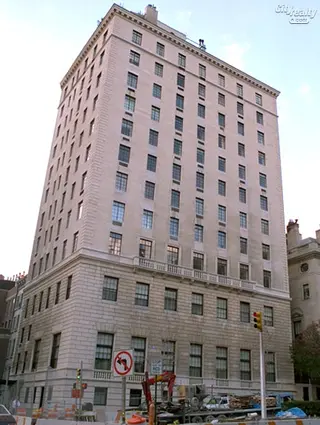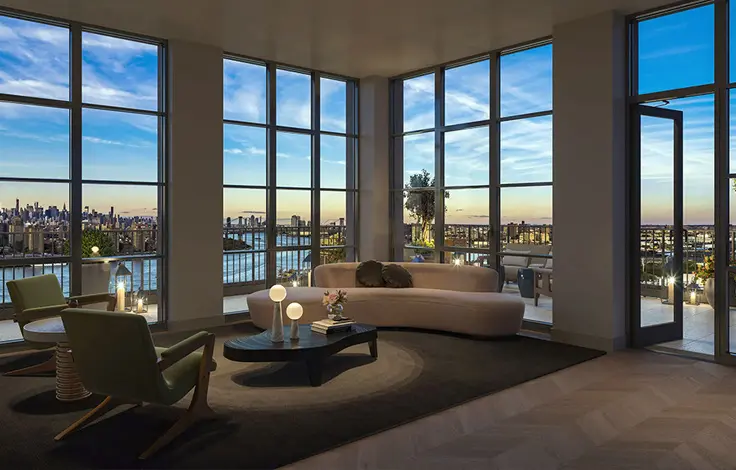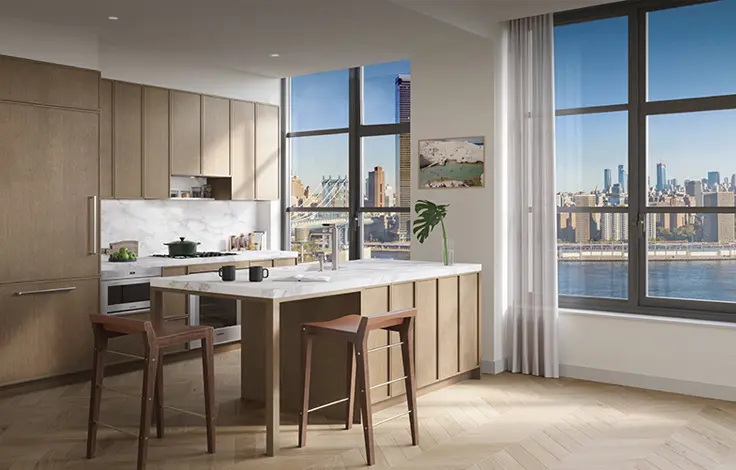 Carter Horsley
Carter HorsleyDec 23, 2011
Carter's Review
One of the most impressive and exclusive buildings on Park Avenue, this 13-story building at 660 Park Avenue on the northwest corner at 67th street was erected in 1926 and has only 12 apartments.
It was designed for Starrett Brothers in Italian Renaissance-style by York & Sawyer, an architectural firm best known for its bank buildings.
Bottom Line
Apart from its imposing entrance marquee and relatively “unadorned” limestone façades, this site has a prime location across from the Seventh Regiment Armory’s “fortress” and an awesome history.
Description
Simplistic is style, yet regal in form, this limestone-clad structure displays balanced fenestration and a quoined corner. The three-story base is rusticated and the side street entrance is topped by a slender iron marquee. A balustraded beltcourse defines the first and third floor levels. The roofline is flat and adorned with a pronounced cornice and dentil molding.
Apart from the maisonette, the building is similar to another developed by Starrett Brothers and designed by W. L. Rouse and L. A. Goldstone at 760 Park Avenue and completed in 1924, according to Andrew Alpern's excellent book, "New York's Fabulous Luxury Apartments with Original Floor Plans from the Dakota, River House, Olympic Tower and Other Great Buildings," (Dover Publications, Inc., 1987).
Amenities
The building has a doorman and storage.
Apartments
The luxurious and elegant building has the city's most spectacular maisonette, a 27-room triplex with its own entrance on the side-street that leads up marble stairs into the apartment's foyer. The maisonette has its own address, 666 Park Avenue.
The lower two floors have double-height entertaining rooms, including one that is 46 feet long, 22 feet wide and 18 feet high. The apartment was specifically designed by John Russell Pope, the architect of the National Gallery in Washington, D.C., for Mrs. William K. Vanderbilt II, the former Virginia ("Birdie" Graham Fair, a daughter of James Graham Fair, a mining magnate who opened the Comstock Lode of silver in Nevada and became a U. S. Senator.
A September 29, 1927 article in The New York Times said that Mrs. Vanderbilt, who had divorced Mr. Vanderbilt in June, put the apartment, which “it is understood she never occupied,” on the market. While the divorce was pending, the article continued, “she purchased by cable the estate and house of the Late Frank Munsey at Manhasset, L.I.,” adding that the “country place was the pride, first of the late Louise Sherry, who built the house, and late of Mr. Munsey” and “was designed from Marie Antoinette’s palace at Versailles, the Petit Trianon.”
Mrs. Vanderbilt subsequently sold her palatial apartment to Seton Porter, a founder of the National Distillers Corporation and husband of Fredericka V. Berwind, a daughter of a coal magnate.
An April 28, 1938 in The New York Times noted that Mrs. Vanderbilt purchased a large plot on 93rd Street between Madison and Park Avenues with Mrs. William Goadby Loew and on the combined plot they erected “two of the finest town houses in the city.” Mrs. Vanderbilt’s house, the article continued, “was sold about a year ago…to Mrs. and Mrs. Byron S. Foy,” the daughter of Walter B. Chrysler.
In his excellent book, "Park Avenue, Street of Dreams," (Atheneum, 1990), James Trager said that Mrs. Porter was "once called the most beautiful woman in Philadelphia," and had been previously married to the head of the Morgan Harjes Bank in Paris and had "organized and endowed the first privately founded military hospital at the front" in World War I.
In 1938, according to Salwen, the apartment was purchased by Fan Fox, whose family had founded the major department store in Hartford, Conn., and her husband, Leslie B. Samuels.
After her death in 1970, the apartment was acquired by Arthur Sackler, the owner of a medical advertising agency and a medical publication and a major art collector. He died in 1987, but his widow, Gillian, remained in the apartment.
A July 16, 1981 article in The New York Times stated that “surely the greatest maisonette ever constructed in New York is the 21-room triplex at 666 Park Avenue.”
“To call it a maisonette at all is rather like calling a Bugatti a runabout – this is not the small insertion on the ground floor of an apartment building that most maisonettes are, those little and charming places that coyly pretend to be both apartments and townhouses. No mistakes can be made about this place. It is not little, it is not coy, and it is not, in the conventional sense, charming,” the article continued.
“It is grander than almost any townhouse,” it declared, adding that “it combines the great sprawl of an apartment that runs for half a block with the sumptuousness of a house that rises, level upon level….The centerpiece of the apartment is a 50-foot-long, 24-foot-high drawing room with 17th Century pine paneling, brought from Spettisbury Manor in the west of England and installed in a room that the architects had shaped to accommodate it. There are also rooms of early 17th century French Chinoiserie from the Chateau de Courcelles in northwestern France, and sections of Georgian paneling from a house on Grosvenor street in London.”
History
In his September 27, 2012 “Streetscapes” column in The New York Times, Christopher Gray wrote that “In early 1926 Frederick Ecker, a vice president of Metropolitan Life Insurance and later its president, hired York & Sawyer to file plans for a sumptuous co-op building on the sunny side of Lenox Hill, soon called 660 Park Avenue.”
“Most other apartment houses on Park were speculative ventures, but Mr. Ecker was building for himself and at least one friend, Darwin Kingsley, head of New York Life. York & Sawyer was by this time a safe, sober firm of bank architects, and it designed a very safe, very sober all-limestone building of the most discreet kind. Indeed, take away a few details and 660 would be a blank modern box of the type now so reviled. There was one difference: a sweep of larger windows on the second floor. This was the principal floor of a three-story maisonette purchased by Virginia Vanderbilt for $195,000 in early 1926, before the building was complete….As it happens, Mrs. Vanderbilt was deserting her house at 666 Fifth Avenue, which she sold for $1.5 million, and it may have been she who selected a separate number for the maisonette - 666 Park Avenue.”
“Mrs. Vanderbilt and her husband, William K. Vanderbilt Jr., had been living apart since 1909, and her choice of location was peculiar,” according to Mr. Gray, “because Mr. Vanderbilt had since 1923 owned a maisonette apartment across the street at 655 Park Avenue. In any event, she had a change of heart and sold the maisonette in September 1927, a few months after filing for divorce. The buyer was Seton Porter, an engineer who had done very well in the liquor industry. Head of National Distillers, he was also chairman of the American Sumatra Tobacco Company, and a director of the General Precision Equipment Corporation, Republic Aviation and 20th Century-Fox.
Mr. Gray noted that “early residents of 660 included William T. Dewart, the publisher of The Sun; Francis Weld, a founder of the investment banking firm White, Weld; and Albert H. Wiggin, the chairman of Chase National Bank,” adding that Mrs. Vanderbilt “built the French neo-Classical house at 60 East 93rd Street now owned by the antiques dealer Carlton Hobbs.’
In 1939, the maisonette became the home of Edward M. Stout, a woolens manufacturer, and his wife, Agnes, Mr. Gray noted, adding that they sold the apartment to ‘Evander Schley, who owned, among many other concerns, the Chihuahua Mining Company.”
Mr. Gray observed that “Mr. Schley and his wife, Sophie, had an active entertainment schedule” and that “the magazine feature ‘Life Goes to a Party’ went to the maisonette in 1947 and encountered Lana Turner, the Duchess of Windsor and Samuel Goldwyn, among others.
The May 133, 2013 entry at Tom Miller’s excellent website www.daytonianinmanhattan.com, recounts some of the site’s history prior to the erection of the present building on the site.
It noted that Susan Grigsby, the widow of Colonel Lewis Braxton Grigsby, “kept up appearances in the horse sporting circles of Lexington, Kentucky – she was so popular that reportedly three racehorses were named after her, including the winner of the 1884 Kentucky Derby.”
“So,” the article continued, “Susan Grigsby made a life-changing decision. In order to keep her children in Catholic-operated schools - son Braxton in Dayton, Ohio at St. Mary’s Seminary and Emelie in an Ursuline convent in Brown County, Ohio - she opened a high-end brothel in Cincinnati. Young Emelie received an education in culture and creativity….She also left with a troubling awareness. The nuns had revealed her mother’s profession to her, saying it was now her cross to bear. Emilie realized that the only way to escape the fate her mother endured was to acquire money and social status. Her brother, Braxton, became private secretary to the Chicago financier Charles T. Yerkes. Yerkes controlled most of the city’s street railway system and in 1892 donated nearly $300,000 to the University of Chicago to build the Yerkes Observatory in Wisconsin….That same year he met the sixteen-year old Emilie Grigsby. The married Yerkes was smitten with the teenaged Kentucky belle….Also smitten with the beauty was Yerkes’s son, Charles Edward, and within months an impending engagement was rumored. Emilie apparently liked young Charles - perhaps even loved him - but the golden goose was not the son, but the father. When it became evident that Charles's intended wife was seeing his father the romance was off and for months the father and son did not speak.”
In 1896, according to the article, the elder Mr. Yerkes built a mansion at 864 Fifth Avenue in New York and began building another one, two blocks away, for Emilie.
Albert Herter painted canvas panels for the house and Emilie filled it with jade, Flemish tapestries and created a Louise XVI “rose room,” and a Napoleonic bedroom.
She traveled to Europe in lavish style, arousing the curiosity of Manhattan’s “wealthy” and “It would not be long before the story of Emilie’s mother was discovered as well as the source of the fortune,” the article recounted, and “The doors of Fifth Avenue quickly began closing.”
On July 9, 1911, an article in The New York Times reported on a reception she gave for various earls and countesses, adding that she was off to Paris but would return in England in August “to pay a round of country house visits, including one to the Duke of Marlborough at Blenheim.’
Reports began to circulate that she had become close with Princess Mary and The Times reported that an opera performance she “sat next to the Duchess of Marlborough.”
She announced her intention to sell her New York belongings and settle down in London, but, the article continued, “she was found out” and “the cables that leaked her social triumphs and personal relationship with the royal family had come from her and Buckingham Palace issued a statement that if she had been at the coronation, “her presence was officially unknown.”
After her sale of New York property, she “sailed away never to return,” but she still made headlines as “shortly after her departure, she was involved in a divorce case brought by the wife of Dr. Henry P. Loomis, who had been physician to Mr. Yerkes.” Her mansion subsequently was divided into apartments, but she managed to persevere and entered William Butler Yeats and Auguste Rodin in her house in Mayfair and offered her country house for a dinner meeting for Field Marshall Lord Kitchener. She died in 1964, unmarried, and the article said that The Times of London noted that “society was nervous of accepting her but she could out-entertain her rivals with wines and cooking beyond their ken.”
One suspects to view her tale on PBS, especially since she is one of three scandalous women profiled by Jonathan Walker last year in his book “The Blue Beast: Power and Passion in the Great War.”

- Co-op built in 1927
- Located in Park/Fifth Ave. to 79th St.
- 11 total apartments 11 total apartments
- 3 recent sales ($9.7M to $12M)
- Doorman





 6sqft delivers the latest on real estate, architecture, and design, straight from New York City.
6sqft delivers the latest on real estate, architecture, and design, straight from New York City.
